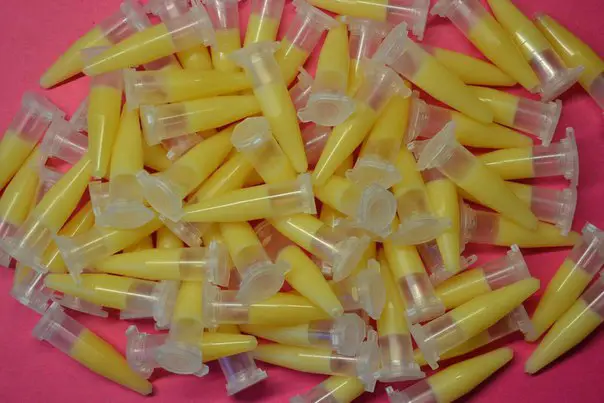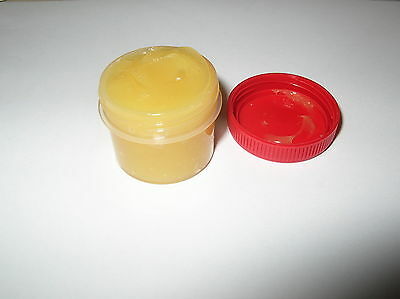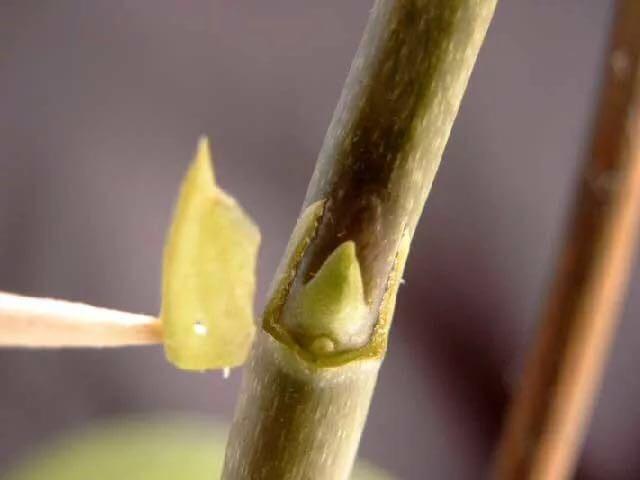Orchids are loved by many flower growers for their bright, showy flowers. But in order to achieve flowering from a capricious and demanding plant in care, you will have to regularly devote a lot of time and effort to it. Among the most common problems that growers face is the lack of offspring and flowering. The use of Keiki paste on orchids, a drug with undoubted advantages, will help to solve them.

What is Keiki paste?
Blooming orchids are the dream of any grower, but sometimes plants need a little help.
Keiki paste is a plant hormone very popular with flower growers. It is mainly used by those who grow orchids, but there are other plants that the drug will help a lot – saintpaulias, begonias, roses, camellias, hibiscus, citrus fruits, succulents, ficus, dracaena, and so on. It is based on cytokinin (aka 6-benzyl amino purine). Also, the paste contains nutrients and vitamins useful for plants, for example, penetrant. It looks like a viscous liquid of honey or yellow-white color; for sale, it is packaged in small ampoules.
What is Keiki paste used for?
The main thing for which the flower growers appreciate the drug is the ability to accelerate cell division and regulate metabolism by stimulating the synthesis of amino acids. Thus, it is possible to awaken “dormant” growth and flower buds, make the flower grow faster, make flowering longer and more abundant, even prolong the existence of aging and dying shoots and give the plant the desired shape by growing shoots where necessary. Also, the drug is indispensable for the resuscitation of a plant that has suffered from mistakes made by a florist when caring for it.
Under the influence of Keiki paste, active cell division begins in the treated area
With the correct application of the product, after 10-15 days the plant will form a new growth bud if a “bare” section of the shoot was treated or if it forms a new shoot or peduncle while processing an existing bud. If we talk about orchids, then only this tool gives one hundred percent confidence that the “offspring” will be formed.
Yellow Oncidium Orchid cae: Watering, Temperature, Potting.
Advantages and disadvantages of Keiki Paste

Keiki paste is not a panacea that can bring a badly damaged plant back to life. But she has a number of undoubted advantages. Often this is the last hope of the grower when all other biostimulants and other means have already been tried. The steady growth of its popularity is facilitated by the low price and low consumption of the drug. Its use for orchids is highly recommended if:
- For a long time, the flower was forced to exist in an unsuitable microclimate or suffered from improper care and is now in a critical condition.
- The plant refuses to “wake up”, although the dormant period has already ended.
- The orchid looks unaesthetic due to the fact that the leaves and pseudobulbs grow asymmetrically, “tilting” to one side of the pot.
Positive effects of Keiki paste on orchids:
- Activation of growth buds, which have been in their infancy for a long time.
- Formation and stimulation of the growth of new shoots and “babies”.
- Stimulation of flower bud formation, longer and more abundant flowering.
- Increasing the general endurance of the plant, its adaptability to a not quite suitable microclimate.
- Inhibition of the aging process, increasing the life of the plant.
If you use Keiki paste according to general recommendations, the orchid will not be harmed. For a person, the product is also safe, although any work with it is still advised to be carried out with rubber gloves, and then wash your hands thoroughly. The disadvantages of the drug are as follows:
- The need to calculate the required amount of paste “by eye”. There are no clear criteria and instructions about how much drug a particular plant needs, and exceeding the dosage leads to leaf deformation, curvature of shoots, and other deformities.
- Gradual addiction. After the first treatment, indeed, active growth is observed, but then the development of the orchid almost stops and new artificial stimulation is needed.
- The impossibility of simultaneously using Keiki paste and other stimulants.
- Action at the genetic level. The drug causes plant cells to divide, even if at the moment it is harmful for him (before a dormant period, after an illness, and so on). If the timing is wrong, the orchid becomes very depressed and may even die.
Types of Outdoor Orchids and what is best for your readout.
How to apply Keiki paste?
The best time to use Keiki paste is just before the end of the rest period. Most orchids come out of hibernation in late February or early March.
The main principle in using the product is moderation. If there is already a kidney, a “pea” of the preparation is applied to it, not exceeding 1–1.5 mm in diameter. In its absence, the amount is increased by about 1.5 times, up to 2.5 mm.An excess of the drug causes the simultaneous appearance of several processes, in order to ensure the full development of each of them, the plant will not have enough strength.
Also, do not smear the entire orchid with Keiki paste. The reason is the same – the roots are unable to provide nutrition to the sharply increasing green mass.
If the purpose of using the drug is to form a peduncle, it is applied very sparingly. In order to get new “offspring”, the amount of paste is increased. In the latter case, it is applied to the upper or lower bud, located on the strongest and healthiest peduncle available.
After the procedure, the orchid is immediately provided with conditions suitable for the active growing season. If you continue to keep it at a low temperature, moderate watering and practically without fertilizing, the plant may die, being forced to direct its forces to the formation of new shoots and offspring to the detriment of everything else.
If you still overdo it, and two or more shoots appear from one point of growth, leave only one of them (the one that seems to be the strongest and most developed). Otherwise, very soon the whole “structure” will dry out and fall away.
Keep the drug out of the reach of small children and pets. The best option is the refrigerator. Cytokinin reacts poorly to heat and light, so putting the paste next to a radiator or other working heating device is also not an option. Before use, be sure to check the expiration date of the drug and let it lie for 2-3 hours at room temperature so that the product has the desired consistency.
What cannot be keiki used for?
Like any drug, especially a hormonal one, Keiki paste has a number of “contraindications for use”, more precisely, restrictions. The tool can not always be used if you do not want to do more harm than good to a normally developing orchid. Therefore, it is strongly discouraged:
- Treat orchids heavily affected by diseases and/or pests with Keiki paste. It will not be possible to restore damaged shoots. Such stimulation will only accelerate the death of a weakened plant. Even if it is possible to raise “children”, such offspring will not be guaranteed to be healthy.
- Stimulate the formation of too many shoots or peduncles at the same time. Keiki paste can be applied to each orchid at a maximum of three points. This applies only to perfectly healthy plants with a sufficiently developed root system, which are provided with the correct microclimate and proper care.
- Apply the drug to anything other than shoots. The product is not intended to be used on leaves or roots.
- Use the product on plants up to three years old and young shoots, and even more so on newly transplanted “babies”. They have not yet developed a sufficiently developed root system capable of providing new shoots and peduncles with proper nutrition. Most likely, you will only achieve that the young orchid shed its leaves.
Orchids heavily affected by disease or pests, Keiki will do more harm than good
How to apply Keiki paste: step by step instructions
There is nothing complicated in using Keiki paste. Even a novice florist will cope with the task. The main condition for a successful operation is the presence of peduncles on the orchid.
After 10-15 days, an orchid treated with Keiki paste looks like this
- Examine the orchid for the healthiest, strongest, and most deformed flower stalk.
- Use a sharp, sanitized razor blade or scalpel to make a shallow cut in the stem. Remove the integumentary scales from the existing growth bud by prying it with a sterile needle and removing the remains with tweezers. A small light green bump will open. You need to act very carefully and without haste, it is very easy to damage the kidney.
- Scratch the kidney lightly with your fingernail or needle to allow the drug to penetrate the tissue, but very carefully.
- Pick up the right amount of Keiki paste. A thick needle or toothpick is best for this.
- Spread the preparation evenly over the kidney or the selected shoot area.
- The appearance of a peduncle or a new “offspring” can be expected in a week. But more often the process takes 10-15 days. It’s easy to tell them apart. In the “baby” the tip is very pointed, in the peduncle it is more rounded.
To stimulate the development of lateral shoots in orchids, an incision or scratch should be made in the place where the leaves connect to the roots, rising slightly above the lower pair of leaves, preferably from the side.
The process of applying Keiki paste is a procedure that requires accuracy and patience
How Long Do Phalaenopsis Orchids Live read out the answer?
Further care of the plant
A plant forming new shoots, “babies” or preparing to bloom, needs to create an optimal microclimate and enhanced nutrition. Therefore, orchids treated with Keiki paste are immediately provided with warmth, bright diffused light, the necessary air humidity, timely watering, and regular feeding.
If a plant develops a new peduncle, fertilizers are used containing phosphorus and potassium and a minimum of nitrogen. On the other hand, when offspring appear, nitrogen is more important. There is no need to increase the watering of the orchid. Keep a close eye on the condition of the soil in the pot, not allowing it to dry out or turn into a swamp.
In most of the territory of Russia, it is problematic to ensure sufficient daylight hours in early spring. Therefore, for supplementary lighting, special phytolamps are used, located at a distance of 30-50 cm above the flower. Common fluorescent, energy-saving and incandescent bulbs burn leaves with an unnatural purple or inky purple hue.
Direct sunlight and intense heat are very harmful for orchids at this time. The optimum temperature is around 25 ° C. Ideally, the flower should be placed in the florarium, which allows you to create an optimal microclimate.
In general, more attention should be paid to caring for an orchid at this time than usual, regularly examining the plant. If the right conditions are created and proper care is provided, there will be no problems with the orchid. Otherwise, you need to focus on how the plant looks. The condition of the leaves and pseudobulbs clearly indicates what the florist is doing wrong.
An orchid treated with Keiki paste requires particularly careful care and the creation of an optimal microclimate
How to prepare Keiki Past yourself?

If it is not possible to purchase Keiki paste, the drug can be prepared independently. The ingredients you need are not on the counter in every store, but they are readily available.
You will need anhydrous lanolin (you can ask around in pharmacies that prepare medicines and ointments according to prescriptions), a substance called 6-BAP, which is benzyl adenine or benzyl amino purine (in fact, Keiki itself, it is sold in stores selling chemical reagents), and pure medical alcohol ( 96%). The main component is white, as if fibrous powder, the concentration of the active substance is 98%.
The main component of Keiki paste is 6-BAP
You should not buy a lot of ingredients. Even 100 g of lanolin is enough to make enough Keiki paste to process an entire orchid greenhouse.
The recipe is as follows:
- Dissolve 1 g of 6-BAP in about twice the volume of ethyl alcohol.
- Place 100 g of lanolin in a glass container in a water bath. Keep holding until it becomes similar in consistency to molten paraffin or wax.
- Add the solution, stir vigorously for a few minutes.
- Remove the container from the heat, let stand for 2-3 days without closing the lid. During this time, the alcohol should completely evaporate.
- Stir the paste again. The shelf life of the finished product is 3 years. Store it in a closed dark glass container with a tight-fitting stopper. It is best to place the jar in the refrigerator, but another dark, dry place that maintains a constant temperature of 5-15 ° C is also suitable.
